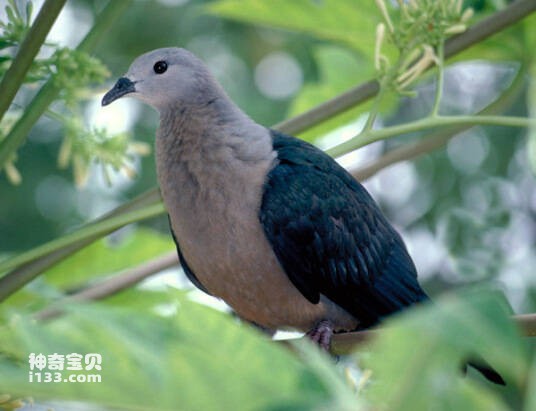Ducula pacifica
IUCN
LCBasic Information
Scientific classification
- name:Ducula pacifica
- Scientific Name:Ducula pacifica,Pacific Imperial-pigeon
- Outline:Landfowl
- Family:
Vital signs
- length:36-41cm
- Weight:No textual research information is available
- lifetime:No textual research information is available
Feature
The body is relatively fat, the head is slightly smaller, the neck is thick and short, and the feathers are soft and denseThe body is relatively fat, the head is slightly smaller, the neck is thick and short, and the feathers are soft and dense
Distribution and Habitat
It is found in American Samoa, Cook Islands, Fiji, Kiribati, New Caledonia, Niue, Papua New Guinea, Solomon Islands, Tokelau Islands, Tonga, Tuvalu, Vanuatu, Wallis Islands and Futuna Islands.
The Pacific Emperor dove inhabits tropical moist lowland forests on the small island and moist mountain forests on the big Island.
Appearance
The Pacific Emperor dove is about 36-41 cm long. The plumage of male and female birds is generally similar. The body is relatively fat, the head is slightly smaller, the neck is thick and short, and the feathers are soft and dense. The mouth is short, the base of the mouth has a wax film formed by soft skin, the jaw is raised, the tip of the upper mouth is enlarged and hard, and the tip of the mouth is slightly curved. The nostrils were covered with feathers. The wings are long and pointed, with 11 primary feathers. The tail feathers are wedge-shaped. The leading edge of the tarsometatarsus is peltate. The feet are short and strong, suitable for walking on the ground. All four toes are in the same plane and there is no webbing between the toes. The head and neck are pink, the beak light gray-black, the belly cinnamon-brown, and the back, tail and wings are black-green or blue-green and lined with SLATE gray.
Details
The Pacific Imperial pigeon (Ducula pacifica, Pacific Imperial-pigeon) has two subspecies.

Pacific Emperor doves < span> In order to feed, they often travel in large groups between islands. They eat mainly the fruits of plants, but sometimes the leaves and flowers. They live in trees, are good at flying and mobile.
Pacific dove Nests among trees or shrubs, forming sealed nests of branches. Only one egg is laid per litter, and both parents hatch together for 14-18 days. The young birds are late sex, and the parent birds often use the "pigeon milk" secreted by the crop to raise the young.
Pacific pigeon has a wide distribution range, does not approach the vulnerable endangered threshold for species survival (distribution area or fluctuation range less than 20,000 square kilometers, habitat quality, population size, distribution area fragmentation), and population trend is stable, so it is assessed as a species without survival crisis.
Listed on the International Union for Conservation of Nature (IUCN) 2012 Red List of Threatened Species ver 3.1 - Low risk.
Protect wild animals and eliminate wild meat.
Maintaining ecological balance is everyone's responsibility!








